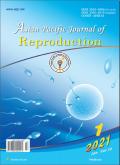Vitamin E modulates androgen receptor gene expression to attenuate ovarian dysfunctions in a rat model of dehydroepiandrosterone-induced polycystic ovary
IF 0.6
Q4 REPRODUCTIVE BIOLOGY
引用次数: 1
Abstract
Objective: To investigate the protective effect of vitamin E in dehydroepiandrosterone (DHEA)-induced polycystic ovary in rats. Methods: Premature female Wistar rats were randomly allocated into four groups, with 7 rats in each group. Group I received corn oil (vehicle) and served as the control group; group II received 0.2 mL of 0.06 mg/g DHEA in corn oil; group III received 200 mg/kg vitamin E; group IV received DHEA plus vitamin E. All treatments lasted for 15 days, with DHEA administered subcutaneously, while vitamin E and corn oil were administered orally. After the experiment, serum samples and ovaries were harvested for biochemical, immunohistochemical, hormonal, and histological analysis. The ovarian mRNA expression of androgen receptor was analyzed by reverse transcriptase quantitative polymerase chain reaction (qPCR). Results: The antioxidant and metabolic enzyme activity significantly decreased in the DHEA-treated rats compared to the control rats (P<0.05). Administration of vitamin E to DHEA-treated rats significantly decreased cytokines and malondialdehyde compared to the DHEA-treated rats. The histological analysis showed reduced atretic and cystic ovaries, increased E-cadherin and Bcl-2 expression, and reduced expression of Bax in the DHEA-treated rats co-treated with vitamin E. The mRNA expression of androgen receptor was upregulated in the DHEA-treated rats compared to the control rats. Conclusions: Vitamin E ameliorates the hyperandrogenic effect of DHEA-induced polycystic ovaries via metabolic, antioxidant, and anti-apoptotic pathways.维生素E调节雄激素受体基因表达以减轻脱氢表雄酮诱导的多囊卵巢大鼠模型中的卵巢功能障碍
目的:探讨维生素E对脱氢表雄酮(DHEA)诱导的大鼠多囊卵巢的保护作用。方法:将早产雌性Wistar大鼠随机分为4组,每组7只。第一组给予玉米油(载体)作为对照组;第二组接受玉米油中的0.2mL 0.06mg/g DHEA;Ⅲ组给予维生素E 200mg/kg;第四组接受DHEA加维生素E。所有治疗持续15天,DHEA皮下给药,维生素E和玉米油口服给药。实验结束后,采集血清样本和卵巢进行生化、免疫组织化学、激素和组织学分析。应用逆转录定量聚合酶链反应(qPCR)检测卵巢雄激素受体mRNA的表达。结果:与对照组大鼠相比,DHEA处理组大鼠的抗氧化和代谢酶活性显著降低(P<0.05)。与DHEA处理的大鼠比较,DHEA治疗组大鼠给予维生素E可显著降低细胞因子和丙二醛。组织学分析显示,与对照大鼠相比,DHEA处理的大鼠闭锁性和囊性卵巢减少,E-钙粘蛋白和Bcl-2表达增加,Bax表达减少。结论:维生素E通过代谢、抗氧化和抗凋亡途径改善DHEA诱导的多囊卵巢的高雄激素作用。
本文章由计算机程序翻译,如有差异,请以英文原文为准。
求助全文
约1分钟内获得全文
求助全文
来源期刊

Asian Pacific Journal of Reproduction
Veterinary-Veterinary (all)
CiteScore
1.70
自引率
0.00%
发文量
588
审稿时长
9 weeks
期刊介绍:
The journal will cover technical and clinical studies related to health, ethical and social issues in field of Gynecology and Obstetrics. Articles with clinical interest and implications will be given preference.
 求助内容:
求助内容: 应助结果提醒方式:
应助结果提醒方式:


